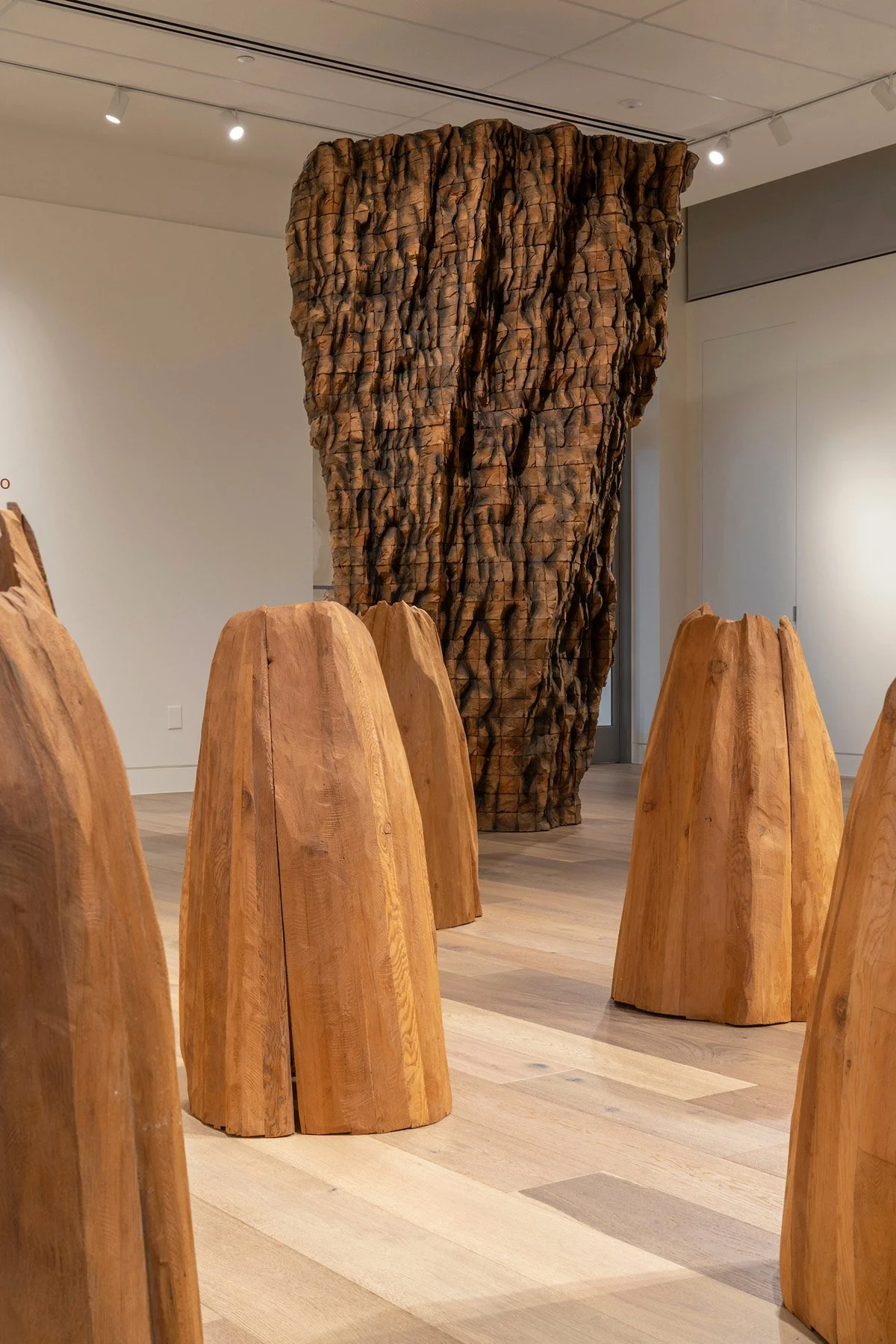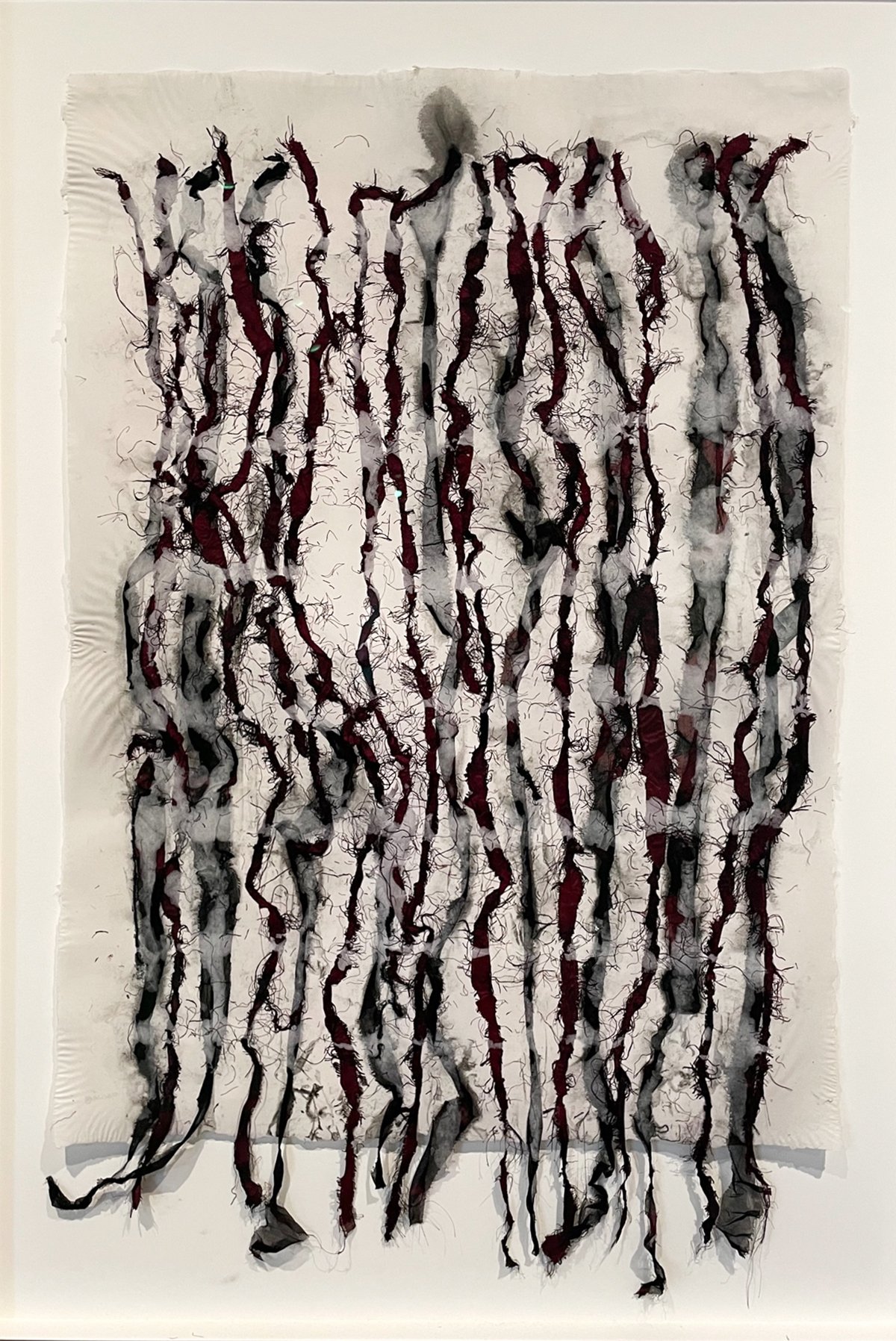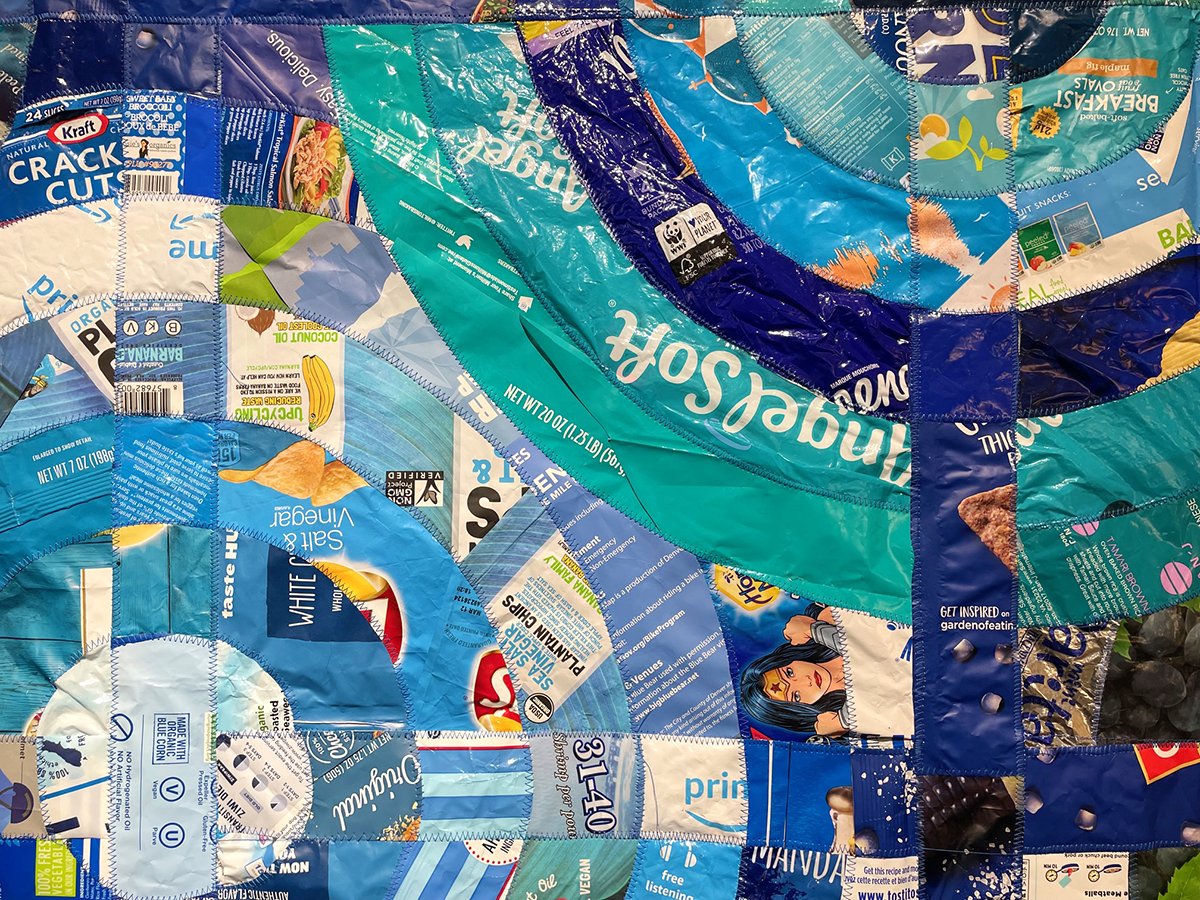The Contour of Feeling
Ursula von Rydingsvard: The Contour of Feeling
Denver Botanic Gardens, Freyer-Newman Center
1007 York Street, Denver, CO 80206
April 30-Sept. 11, 2022
Admission: Adults: $15, Seniors 65+ and Military: $11.50, Children 3-15 and Students: $11, Members and Children 2 and Under: free
Review by Danielle Cunningham
Monstrous cedar sculptures as large as small trees characterize Ursula von Rydingsvard’s exhibition The Contour of Feeling. The title reflects both the poetics of the sculptures and the tragic, triumphant poetry that could be made about the artist’s childhood. Along with her family, German-born Ukrainian and Polish artist Ursula von Rydingsvard spent her early years as a forced laborer under the Nazis. After World War II, the family traveled among displacement camps. These are experiences she sometimes references in her work, though minimally. [1]
An image of Ursula von Rydingsvard and her exhibition The Contour of Feeling at the Denver Botanic Gardens in 2022. Artwork courtesy of the artist and Galerie Lelong & Co., New York. Image by Scott Dressel-Martin.
Von Rydingsvard is best known for making large-scale sculptures using natural materials, most notably cedar. Now in her 80s, the artist remains remarkably obsessed with the wood despite its notorious level of difficulty to hand carve. She has also become allergic to it and must wear a special suit when working with cedar. [2]
An installation view of Ursula von Rydingsvard’s exhibition The Contour of Feeling. Image by DARIA.
While her material results in a finished product that is alluring, it is von Rydingsvard’s process that gives her work its sense of raw emotional power and wonderment. Beginning by mapping out forms in her studio, the artist then presses planks together to achieve a general shape, which balances delicately between total abstraction and figuration. She then hand-cuts grooves of various sizes that run in different directions.
Ursula von Rydingsvard, Krasawica II, 1998-2001, cedar and graphite. Artwork courtesy of the artist and Galerie Lelong & Co., New York. Image by Scott Dressel-Martin.
A detail view of Ursula von Rydingsvard’s Krasawica II. Image by DARIA.
She also sometimes rubs the cedar with graphite to obliterate the wood’s recognizable, circular grain, replacing it with a somewhat chaotic appearance composed of uneven tones. [3] With this process, von Rydingsvard emphasizes her own hand, using her sculptures to reveal indescribable feelings and elicit themes of repetition, physical work, and renewal.
A view of works in Ursula von Rydingsvard’s exhibition The Contour of Feeling. Artwork courtesy of the artist and Galerie Lelong & Co., New York. Image by Scott Dressel-Martin.
The exhibition is as colossal in the number of works as the individual sculptures are in size. It is divided among three galleries with a mixture of wall-mounted and free-standing works in each. The tallest works nearly touch the ceiling while the smallest occupy space differently but also dramatically, spreading across walls, floors, and at least one table.
Ursula von Rydingsvard, COŚ, 2017, cedar and graphite. Artwork courtesy of the artist and Galerie Lelong & Co., New York. Image by Scott Dressel-Martin.
One of the tallest works, COŚ, has cedar panels that are pressed and carved so as to create a gridded surface. The panels appear to undulate with the artist’s marks, which somehow flow gently around the sculpted surface despite being roughly carved. Deep, dark crevasses travel vertically, adding a haunting and mysterious power to the work and highlighting the artist’s emotional intensity. [4]
Ursula von Rydingsvard, Collar with Dots, 2008, cedar and pigment. Image by Danielle Cunningham.
Another work, Collar with Dots, is similarly intense though less ominous. Occupying the entirety of a central wall, its dimensionality and contrasting tones are playful yet primal, as though carved by some distant ancestor. Its title echoes its shape, which is an arch resembling a necklace or a collar.
Embellished by an outer border of longish vertical panels and covered in small, crisscrossing grooves, the work’s interior has a heavily textured, graphite-rubbed surface containing unevenly spaced dots of differing sizes. These are arranged into a pattern whose meaning is known only to the artist, untranslated yet deeply poetic, and reflective of the artist’s intuitive process. That the work appears with its English title is an anomaly for von Rydingsvard, who prefers to keep her titles in vernacular Polish. She does so as a means of connecting to her heritage while reserving bits of meaning for herself and highlighting her love of language. [5]
Ursula von Rydingsvard, Untitled (works on paper), 2017-2020, linen handmade paper and mixed media. Image by Scott Dressel-Martin.
Diverging from the large format, the series Untitled (works on paper) is a seven-piece, framed paper, fabric, and graphite wall installation. It extends horizontally, the thick swathes of graphite emerging from the whiteness of each work, jumping up and down like a transcription of sound waves. Dark pigments dominate these objects, crisscrossing their surfaces in lines and dots or covering them in swirling black masses.
A detail view of one piece in Ursula von Rydingsvard’s Untitled (works on paper) series. Image by DARIA.
In some pieces, the fabric unravels while in others, it remains intact, establishing a boundary for the marks and maybe a restraint for the artist’s complex thoughts and feelings. Though differently composed, the seven works have in common many tangled threads and unkempt marks, obscuring the material and leading to a desire to see what’s beneath.
Ursula Von Rydingsvard, Untitled (nine cones), 1976, cedar. Image by Danielle Cunningham.
Though most works in the exhibition are recent, Untitled (nine cones) is from 1976. Smaller than COŚ and other giant pieces, these nearly identical nine sculptures—arranged in a grid formation on the gallery floor—look fragile, suggesting the artist’s vulnerability. In comparison with the sturdy, larger works, these seem as though the cedar has been pounded flat to the thickness of paper, allowing for a softer shape and overall aesthetic. Like many other sculptures in the exhibit, this work strongly alludes to nature and mimics the crater of a volcano or a feeding anemone. With each sculpture’s dark interior, the work also possesses a vein of darkness and ambiguity that runs throughout the show.
An installation view of Ursula von Rydingsvard’s exhibition The Contour of Feeling with Untitled (nine cones), 1976, cedar, in the foreground. Artwork courtesy of the artist and Galerie Lelong & Co., New York. Image by Scott Dressel-Martin.
Von Rydingsvard’s dedication to her materials is impressive, even a little obsessive, which has proven to be advantageous for her. She has created a body of work that expresses both the significance and the sustenance of the natural world as well as the unending possibilities of art and creativity. Her vulnerability is channeled through cedar’s hard surface, so that it shields her in a way, allowing her the space to express a spectrum of emotions. Her magical translation of emotion into tangible objects mimics language and poetry, while her expert movement between abstraction and figuration allows for a visceral, imaginative experience.
Danielle Cunningham is an artist, scholar, and independent curator. She writes about science fiction, gender, sexuality, and disability, with an emphasis on mental illness. The co-founder of chant cooperative, an artist co-op, she holds a master’s degree in Art History and Museum Studies from the University of Denver.
[1] From the artist’s statement in the gallery.
[2] Karen Michel, “When Sculpting Cedar, This Artist Is Tireless and Unsentimental,” NPR, April 28, 2013: https://www.npr.org/2013/04/28/177969148/when-sculpting-cedar-this-artist-is-tireless-and-unsentimental.
[3] Ibid.
[4] From the artist’s statement in the gallery.
[5] Ibid.


















